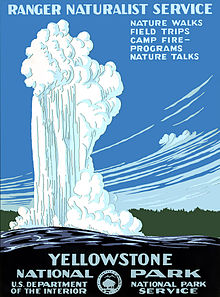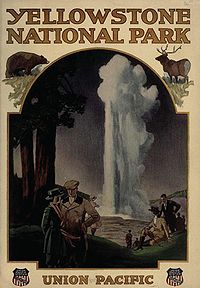
Historical poster of Yellowstone from 1938
A Brief History of the Park
The human history of the Yellowstone region goes back more than 11,000 years.
Ancestors to contemporary Blackfeet, Cayuse, Coeur d'Alene, Bannock, Kiowa, Nez Perce, Shoshone, and Umatilla-among others-visited geysers, conducted ceremonies, hunted, gathered plants and minerals, and engaged in trade. The Sheep Eaters may have lived in what is now Yellowstone National Park more full time than other native people. They acquired their name from the bighorn sheep whose migrations they followed.
The First European-Americans
John Colter, a fur trapper, appears to have been the first European-American to see this land of hot springs and geysers. He probably passed through during the winter of 1807-08 while searching for native customers for a new trading post down the Yellowstone River. The fur trade flourished briefly in the Rocky Mountains, bringing such men as Jim Bridger, Joe Meek, Daniel Potts, Osborne Russell, and Warren Angus Ferris into the area that is now Yellowstone National Park. The fur trade came to an end about 1840 as furs grew scarce and fashions changed. The trappers disappeared from the Yellowstone Plateau, leaving it a nearly-forgotten wilderness.
Looking for Gold
The discovery of gold in neighboring Montana brought prospectors to the Yellowstone area about twenty years later. During 1863-1871, prospectors crisscrossed the Yellowstone Plateau and searched every crevice for gold and other precious minerals. Although gold was found nearby, no big strikes were ever made inside what is now Yellowstone National Park. However, some of the knowledge that had been commonplace among the fur trappers was rediscovered, and interest in the geyser region was rekindled.
Expeditions "Discover" Yellowstone
Although Yellowstone had been thoroughly tracked by trappers and tribes, in the view of the nation at large it was really "discovered" by formal expeditions. The first organized attempt came in 1860 when Captain William F. Raynolds led a military expedition, but it was unable to explore the Yellowstone Plateau because of late spring snow. The Civil War preoccupied the government during the next few years.The next group to come into the Yellowstone country for the sole purpose of seeing what it contained was the Folsom-Cook-Peterson expedition in 1869. Their information led to more thorough exploration by the 1871 Washburn-Langford-Doane expedition and the 1872 Hayden expedition. Reports, lectures, and articles by these explorers led Congress to set aside the vast Yellowstone area as a national park on March 1, 1872.
The Park's Early Years
The park's promoters envisioned Yellowstone National Park would exist at no expense to the government. Superintendents received little or no compensation, little help, and often succumbed to politics. Although they were able to build roads, trails, and structures, they failed to stop the destruction of wildlife. Poachers, squatters, woodcutters, and vandals ravaged Yellowstone.

Union Pacific Railway Brochure Promoting Travel to Park (1921)
The Army Arrives
On August 20, 1886, the U.S. Army took charge of the administration and protection of Yellowstone. The Army strengthened and enforced regulations, guarded major attractions, and patrolled the vast interior of the park. However, running a park was not the Army's usual line of work. The troops could protect the park and ensure access, but they could not fully satisfy the visitor's desire for knowledge. Moreover, each of the 14 other national parks established during this period was separately administered, resulting in uneven management, inefficiency, and a lack of direction.
The National Park Service Begins
In 1916, Congress passed the National Park Service Organic Act, creating the National Park Service. Yellowstone's first rangers, which included veterans of Army service in the park, became responsible for Yellowstone in 1918. The park's first superintendent under the new National Park Service was Horace M. Albright, who established a framework of management that guided administration of Yellowstone for decades.
The Legacy of Yellowstone
The years have shown that the legacy of those who worked to establish Yellowstone National Park in 1872 was far greater than simply preserving a unique landscape. This one act has led to a lasting concept-the national park idea. This idea conceived wilderness to be the inheritance of all people, who gain more from an experience in nature than from private exploitation of the land. Scores of nations have preserved areas of natural beauty and historical worth so that all people will have the opportunity to reflect on their natural and cultural heritage and to return to nature and be spiritually reborn. Of all the benefits resulting from the establishment of Yellowstone National Park, this may be the greatest.
The Origin of the Name "Yellowstone"
When French-Canadian trappers traveled through what is today eastern Montana, they asked the Minnetaree tribe the name of the big river. The Minnetaree responded "Mi tse a-da-zi," which translates as "Rock Yellow River." (Historians do not know why the Minnetaree gave this name to the river.) The trappers translated this into French-"Roche Jaune" or "Pierre Jaune." In 1797, explorer-geographer David Thomson used the English version-"Yellow Stone." Lewis and Clark called the Yellowstone River by the French and English forms. Although the English name originally was separated into two parts, subsequent usage formalized the name as a single word-Yellowstone.
Yellowstone National Park was thus named after the Yellowstone River, which has its headwaters on Younts Peak, southeast of the park. The river flows north into the park, forms Yellowstone Lake, and continues its 671-mile journey to join the Missouri River at the Montana-North Dakota border. The Yellowstone River remains the longest river in the United States without a major dam blocking its flow.
For More Information
Indians of Yellowstone Park, revised edition, 2002. Joel C. Janetski
Journal of a Trapper, 1997. Osborne Russell
Myth and History in the Creation of Yellowstone National Park, 2003. Paul Schullery and Lee H. Whittlesey
Restoring a Presence: American Indians in Yellowstone National Park, 2004. Peter Nabokov and Larry Loendorf
Yellowstone Resources & Issues, (annual). Yellowstone National Park staff
The Yellowstone Story, 2 vols., 1996. Aubrey L. Haines
www.nps.gov/yell
www.cr.nps.gov


